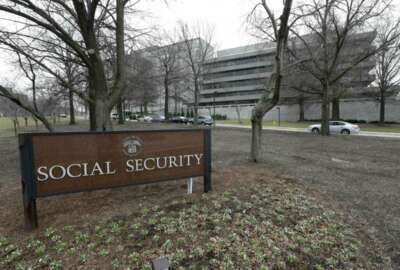Updated: Time for federal employees to return to the office, congressman says
Rep. Jody Hice (R-Ga.), ranking member of the government operations subcommittee, is calling on OPM to facilitate return-to-work plans for the federal workforce...
This story was updated on Friday, May 21, 2021 at 9:45 a.m. to include additional information from Rep. Gerry Connolly (D-Va.), chairman of the Oversight and Reform Subcommittee on Government Operations.
A top Republican on the House Oversight and Reform Committee is calling on federal employees to return to their offices, after the pandemic forced much of the workforce to telework for the last 15 months.
“I write today to urge the federal workforce to return to the fullest possible degree to its
normal places of work,” Rep. Jody Hice (R-Ga.) said Tuesday in a letter to the Office of Personnel Management.
Hice, who serves as the ranking member on the House Oversight and Reform Subcommittee on Government Operations, referenced rising vaccination rates and falling COVID-19 cases across the country, as well as the latest guidance from the Centers for Disease Control and Prevention for fully-vaccinated individuals.
“It is time to begin transitioning to the workplace,” Hice said. “If it is the administration’s intention to prolong remote working arrangements, then it is appropriate to hold a comprehensive policy discussion around related issues.”
The Office of Management and Budget told agencies last week masks were optional for fully-vaccinated employees inside federal facilities.
But in advising agencies on the latest mask requirements, OMB said maximum telework policies remained in effect. At least one agency has said it won’t require employees to return to the office until the end of September.
Many federal employees have been teleworking on a full-time basis since the pandemic began 15 months ago, and at the peak of the health crisis last year, at least 59% of the workforce worked remotely every day, according to OPM data.
OMB imposed more stringent and specific guidelines on agencies in January, when it explicitly instructed them to limit the number of employees working inside federal offices to no more than 25% of normal occupancy levels.
“Prolonging arrangements taken in an exigent situation is not a permanent solution,” Hice said. “Members of Congress from both parties have emphasized that the lack of face-to-face services during the pandemic has had real, negative impacts on veterans, Social Security beneficiaries, and others who need prompt, attentive service from public servants at federal agencies. This is particularly critical for the most vulnerable of our constituents including seniors and low-income Americans, as well as individuals who may not have internet access or the computer skills necessary to navigate an entirely virtual interaction with a government agency.”
Senators on both sides of the aisle have expressed frustration with the Social Security Administration, where field and local offices are open only for members of the public who have a dire need request and an appointment. And House Republicans are disappointed with the National Archives and Record Administration. NARA’s employees have mostly worked from home during the pandemic, but the arrangements have created backlogs at the National Personnel Records Center, which had 500,000 outstanding records requests in March.
“Prolonged remote work is harming Americans’ access to federal agencies and is costing taxpayers,” Hice said in a statement. “OPM needs to prepare federal employees to return to the workforce immediately. America’s government should be leading the way out of the pandemic, not lagging behind the rest of the country.”
If agencies plan to shift to remote work permanently, Hice said he’s interested in how OPM and other agencies will handle a host of other issues. He pointed to the $10 billion the federal government spends annually on buildings and leasing costs, as well as locality pay.
“If fully remote work arrangements continue indefinitely into the future, the taxpayers would benefit from reassessing whether remote workers should be considered eligible for locality pay,” said Hice, who requested a briefing from OPM staff on its plans to address his concerns.
OPM has previously said it’s considering how locality pay may factor into more permanent remote work arrangements, particularly where employees work in regions where the locality pay is higher or lower than the city where the office is located.
New guidance on telework, remote work and other workplace flexibilities for federal employees is also in the works, OPM has said.
But on Thursday, Rep. Gerry Connolly (D-Va.), chairman of the government operations subcommittee, urged OPM to take a more cautious approach.
“I believe that federal employees who need to be in offices should be allowed to return as soon as is practicable,” Connolly said Thursday in his own letter to acting OPM Director Kathleen McGettigan. “Yet we must balance the needs of continuing government operations and providing vital resources to the public with the equally important obligation to protect the health and safety of federal employees so that they can continue to provide those services.”
Connolly said unclear agency safety guidelines and poor communication during the early days of the pandemic led to the death of one of his own constituents, Chai Suthammanont, who he said likely contracted COVID-19 at his agency.
Connolly’s legislation, the Chai Suthammanont Remembrance Act, would require agencies to publish and communicate safety plans before recalling federal employees back to their offices. The House Oversight and Reform Committee advanced the bill last week.
Throughout the pandemic, OMB has taken the lead on most governmentwide decisions on when federal employees should telework and how many can work from their agencies’ offices. OPM is a member of the Safer Federal Workforce Task Force, which the Biden administration established in January as a way to collaborate on issues related to the pandemic.
“Federal agencies remain in a maximum telework posture,” Shelby Wagenseller, an OPM spokeswoman, said Tuesday in an email. “As a co-chair of the Safer Federal Workforce Task Force, OPM is working closely with other members of the Task Force to ensure agencies are protecting the health and safety of the federal workforce, and updating their plans and procedures as CDC guidance evolves.”
Copyright © 2024 Federal News Network. All rights reserved. This website is not intended for users located within the European Economic Area.
Nicole Ogrysko is a reporter for Federal News Network focusing on the federal workforce and federal pay and benefits.
Follow @nogryskoWFED
Related Stories






